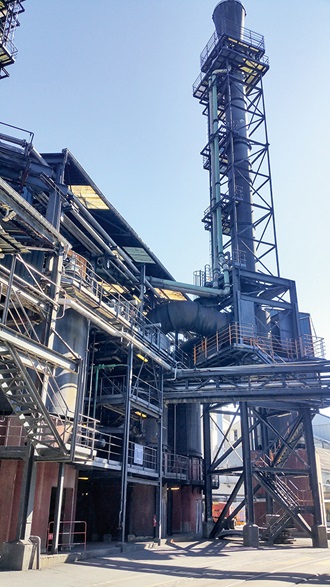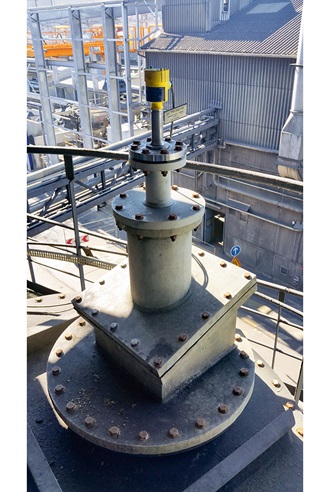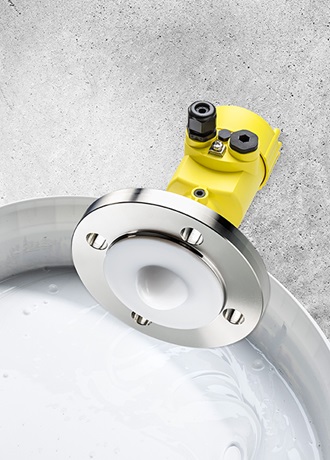VEGAPULS 64 level sensor solves difficult measurement problems in titanium dioxide production
There are always applications which never quite work reliably and therefore require extra monitoring by operators and maintenance personnel. For example, a large French titanium dioxide manufacturer had been looking for quite some time to find a reliable level solution for a particular process. This was because previous devices had delivered inconsistent readings, despite considerable expenditures on service and maintenance. The company only found a solution for the application when they turned to a VEGAPULS 64 level sensor with 80-GHz transmission frequency.
The medium
After the sulphating process, the first production phase of titanium dioxide creates highly challenging conditions for sensors.
Titanium dioxide is the white pigment ingredient used to enhance the protective properties of varnishes and paints in the automotive, food, textile and paper industries. The end users of this product demand the highest standards for both the purity and quality of their titanium dioxide. These requirements make the production of the titanium dioxide very complex and process very hazardous. Therefore, the entire manufacturing process needs to be highly automated. However, the situation for the sensors used in the production is anything but simple: buildup on, and corrosion of, sensors are regular on the list of problems the maintenance staff regularly encounter.
At the titanium dioxide plant at Cristal in Thann, France, there are exceptionally high stresses placed on the sensor materials. One example is shown in the first phase of production after the sulphating procedure, where level sensors are required. First, a weak sulphuric acid is added to a premix of ores and sulphuric acid from a secondary container. The decomposition of materials results in a violent and exothermic reaction in which aggressive and adhesive vapours are generated. After the dissolution and stabilization of the mixture, the containers are then emptied. This process is designed to remove the natural impurities like iron compounds, which would otherwise lead to a discolouration of the pure white titanium dioxide.
The previous unsatisfactory situation
Two different level technologies had been applied to this stage of the production process, but neither of these methods have yielded the desired results. Firstly, an older radar measuring method was used, the device was a heavy and bulky level sensor with an operating voltage of 230 V AC. It had a cone shaped antenna covered with a Teflon coating to reduce adhesion of the product. Later, a bubbler back-pressure level system was also tried. But the measurement results during certain decomposition phases also proved to be unsatisfactory. Despite regular preventive maintenance, which was not only time consuming but hazardous and cost intensive, the devices still delivered unreliable results.
The goal of Cristal was clear – the company wanted to have a reliable level measurement and at the same time reduce the high maintenance costs. In 2016, when VEGAPULS 64, the world's first 80-GHz radar level sensor for liquids was introduced to the market, Cristal immediately took notice.
Convinced by a new solution
Due to the narrow angle of the beam, the sensor can be reliably used even in vessels with internal structures.
After the first demonstration of the new measuring instrument, it became clear to the management at Cristal that they should do a test run with VEGAPULS 64. This company has been a loyal customer of VEGA France for over 30 years and particularly values the trust in the relationship and VEGA’s fast reaction when servicing is needed.
At the beginning it was not clear if VEGAPULS 64 could withstand the stress and strain it is subjected to in the decomposition process.
The first trial was conducted under real conditions in a production vessel. Due to the very narrow focus of the measuring beam of the new instrument, it could simply be mounted in an existing socket, which considerably reduced the engineering and preparation time for the test run. The setup and commissioning of the VEGAPULS 64 was also easy because the false signal suppression procedure was for the most part not necessary.
The measuring results were so accurate and reliable that the VEGAPULS 64 was left in place permanently in the reaction vessel at Cristal. The radar’s performance was so convincing that the old level sensors in the other production vessels were replaced by VEGAPULS 64 as well.
Export this article
Download as PDFShare this article
Comments ({{comments.length}})
{{getCommentAuthor(comment, "Anonymous")}} {{comment.timestamp | date : "dd.MM.yyyy HH:mm" }}
{{comment.comment}}




